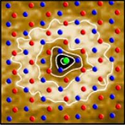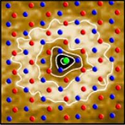A dilute magnetic topological semiconductor?
and have a rich history as very good room-temperature thermoelectric materials, but recently they have been at the center of attention in the rapidly developing field of topological insulators. Although these materials are bulk insulators, they possess topologically protected gapless surface states, protected in the sense that they are immune to disorder, perturbations, or fluctuations. It was recently shown that doping with nonmagnetic copper results in superconductivity.
Now, in an article appearing in Physical Review B, Yew San Hor and collaborators from the chemistry and physics departments of Princeton University, US, show that doping with magnetic manganese makes the compound magnetic, while still preserving the topological surface states that are present in the parent material. Their detailed study shows that, as manganese doping levels are increased, this first gives rise to local magnetic moments, but subsequently leads to a second-order ferromagnetic transition. Scanning tunneling microscopy allows visualizing individual magnetic dopant atoms and reveals no manganese clusters, an indication that the system is a true dilute ferromagnetic semiconductor. Angle-resolved photoemission spectroscopy reveals that, although subtly altered by the doping, the topological surface states are still there just above the ferromagnetic transition temperature. – Alex Klironomos





